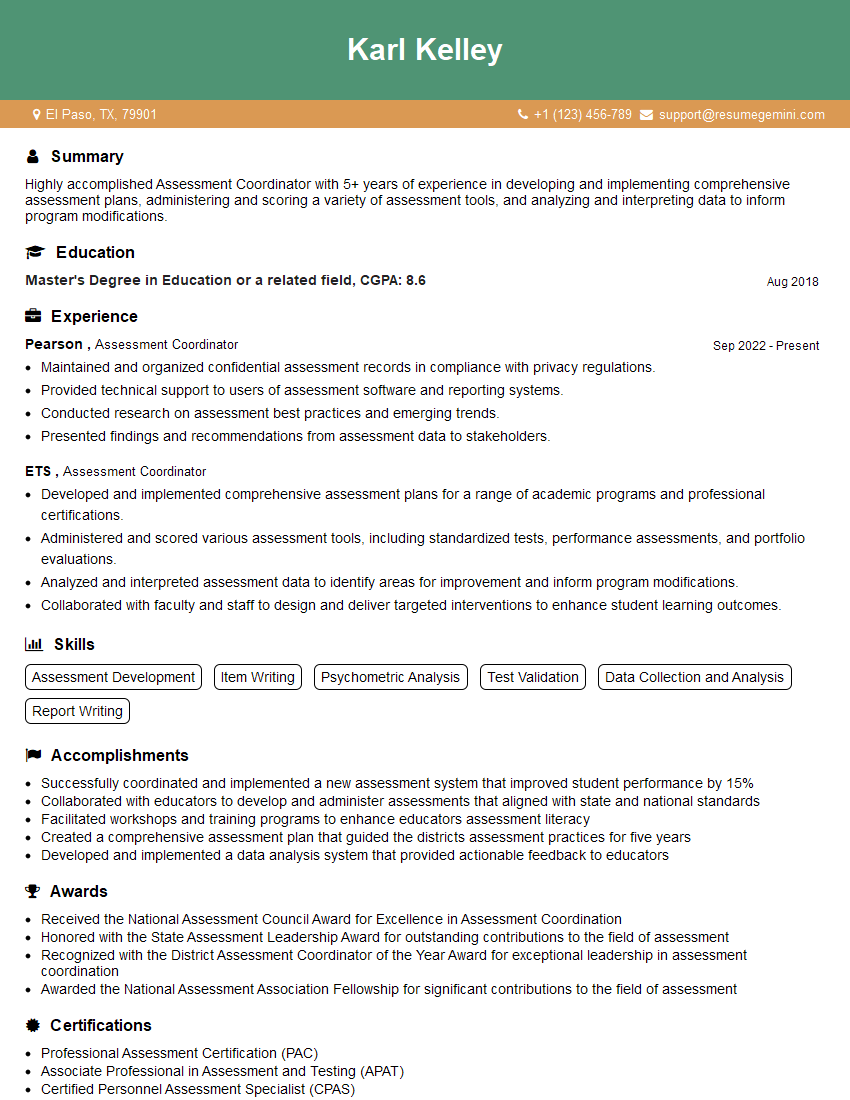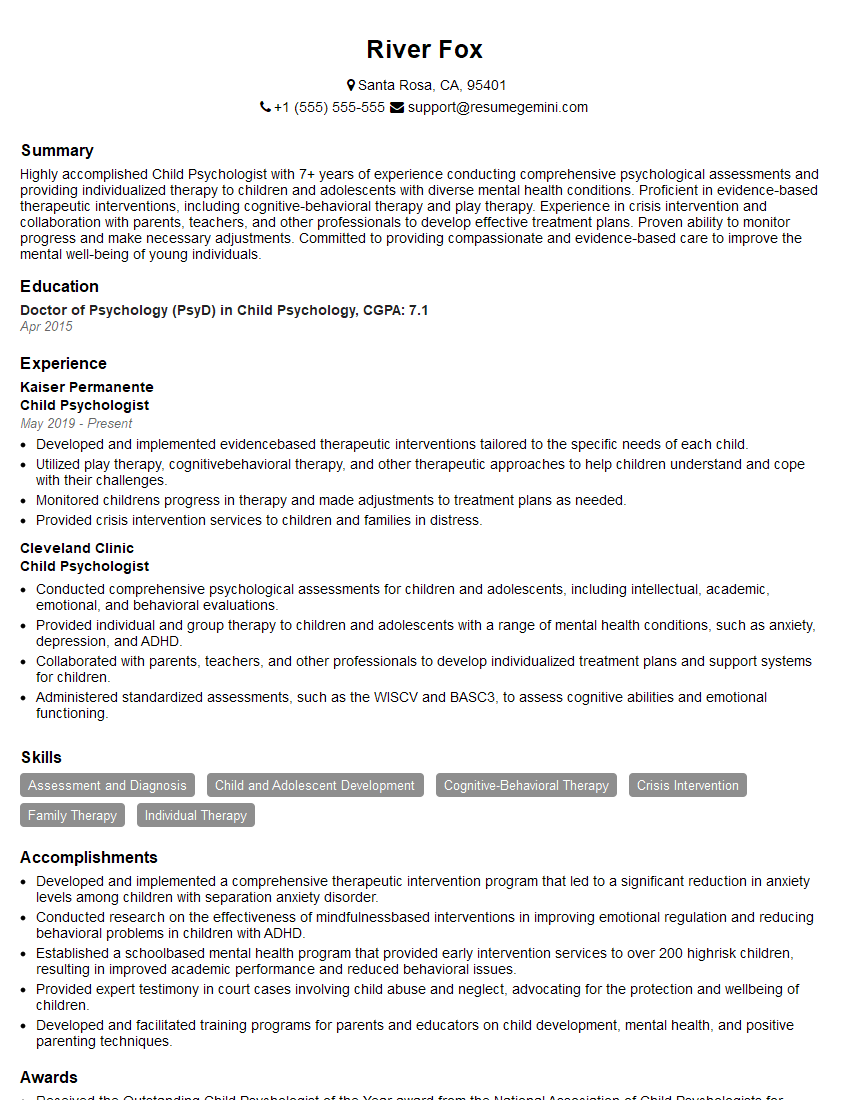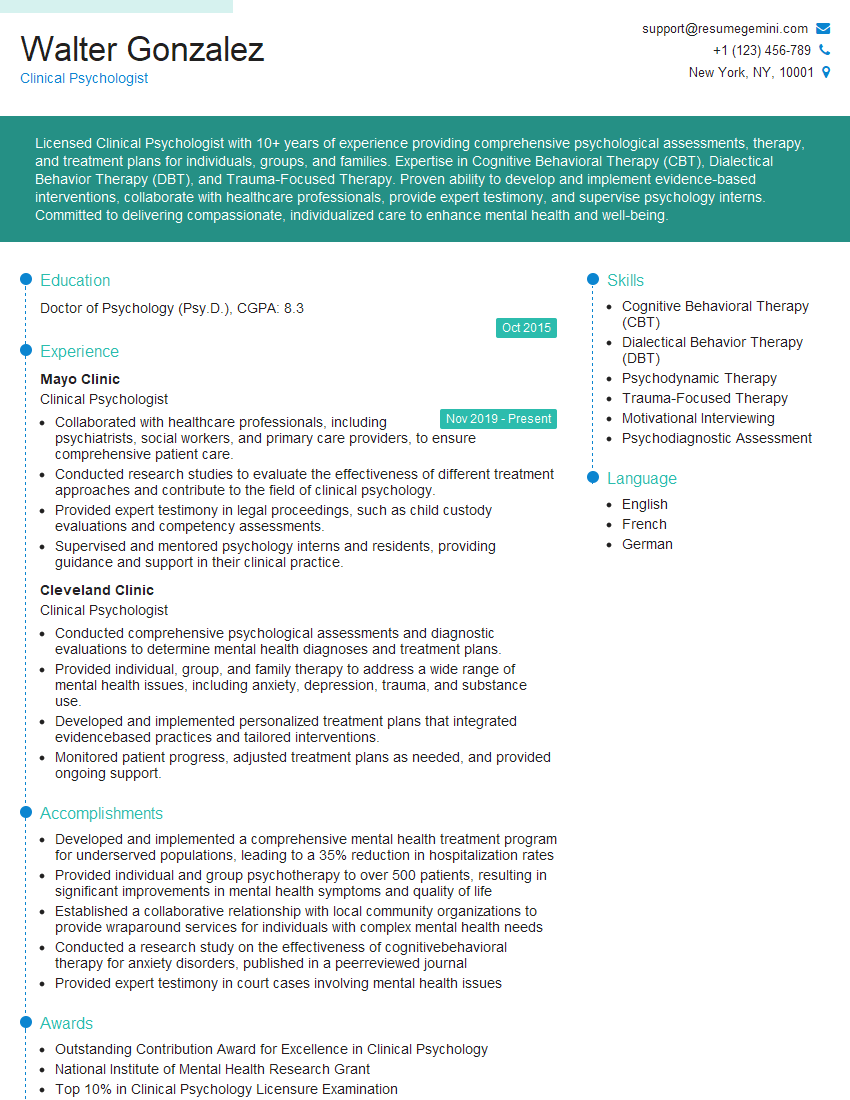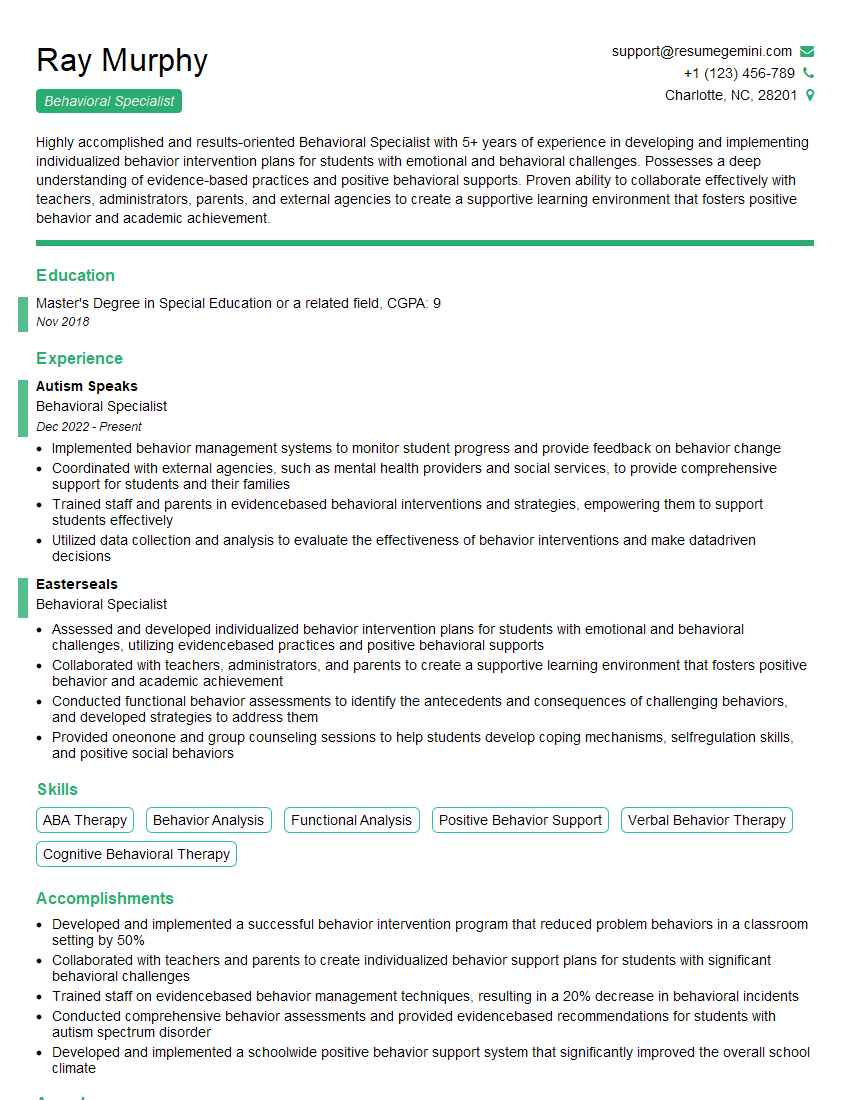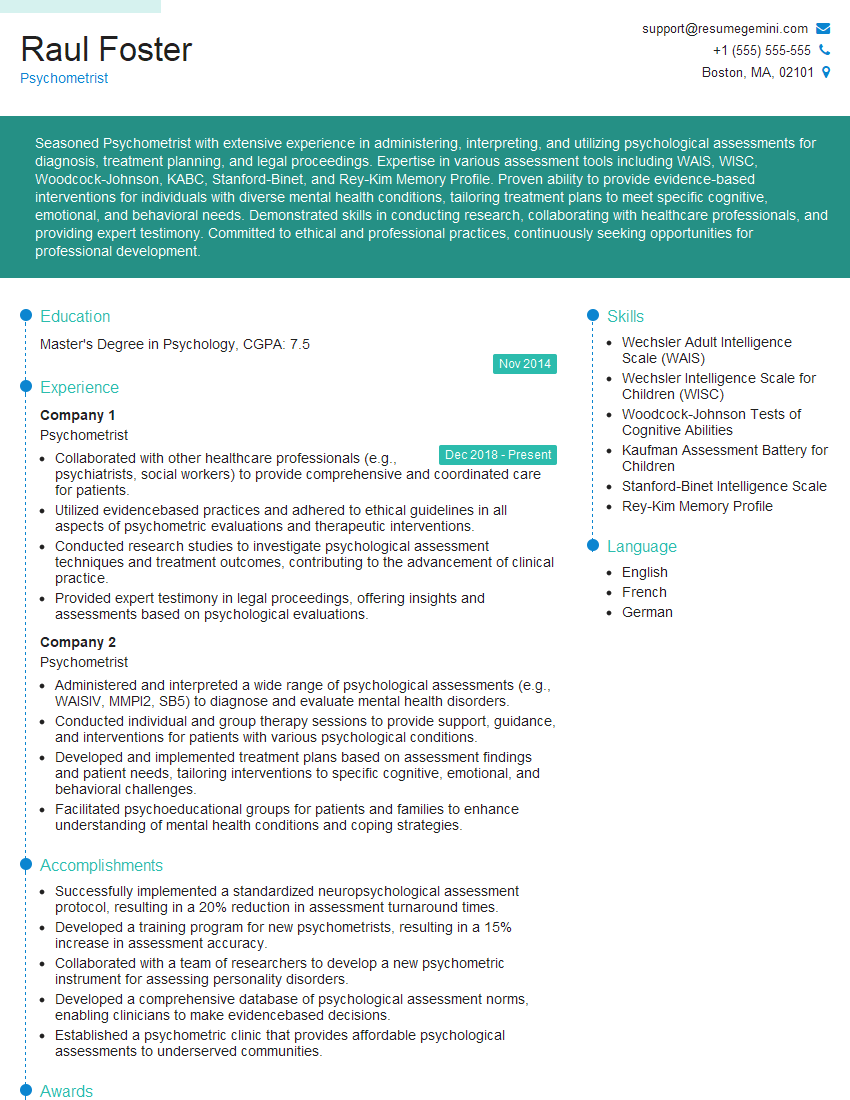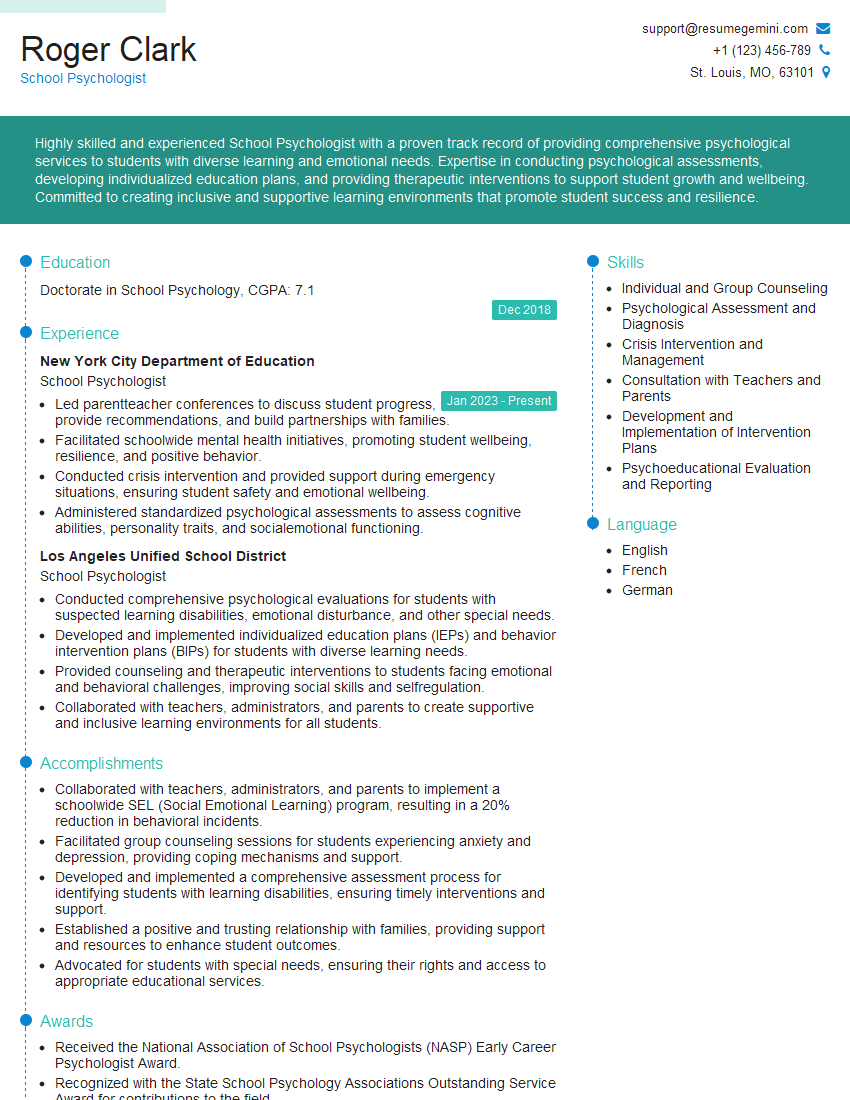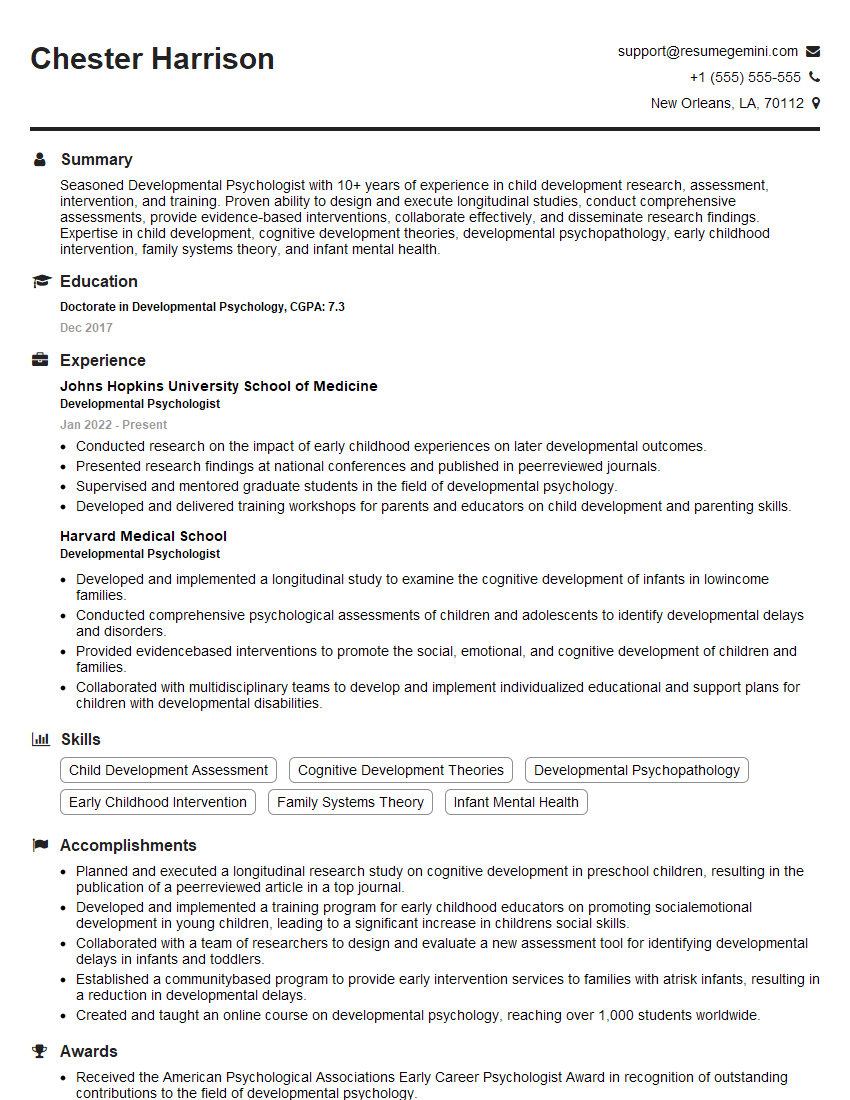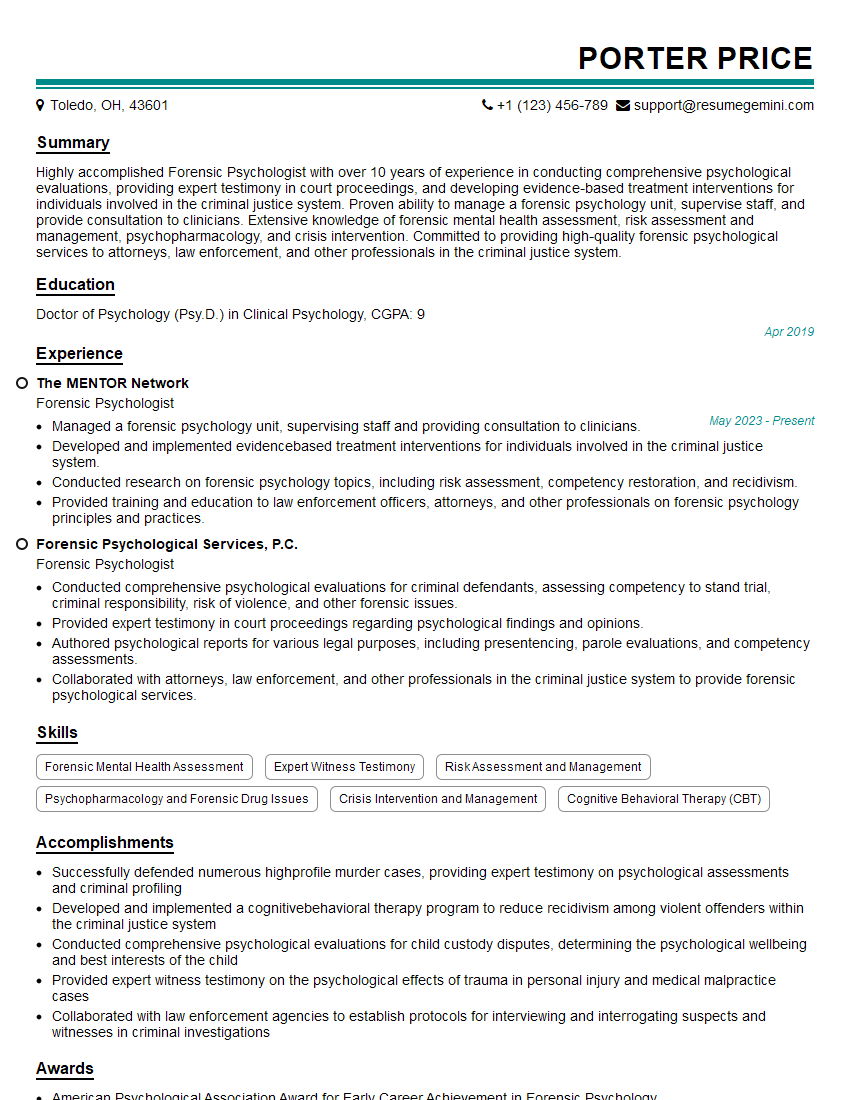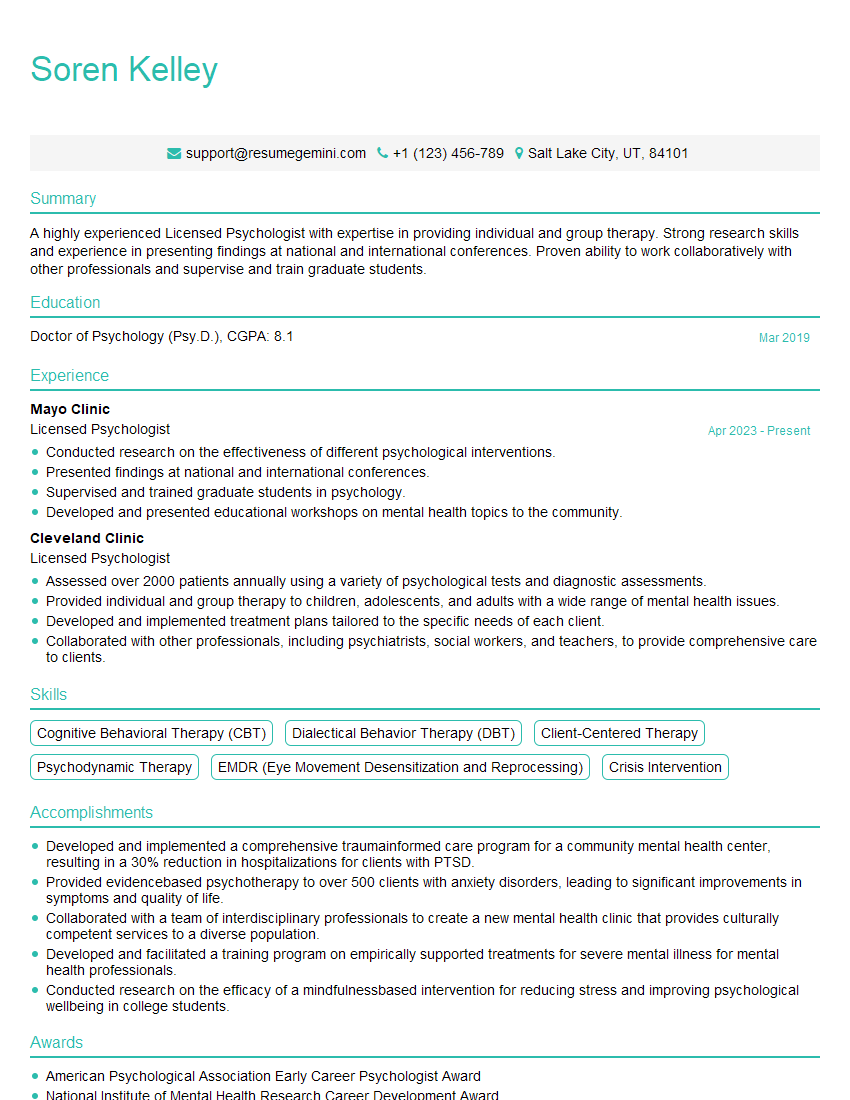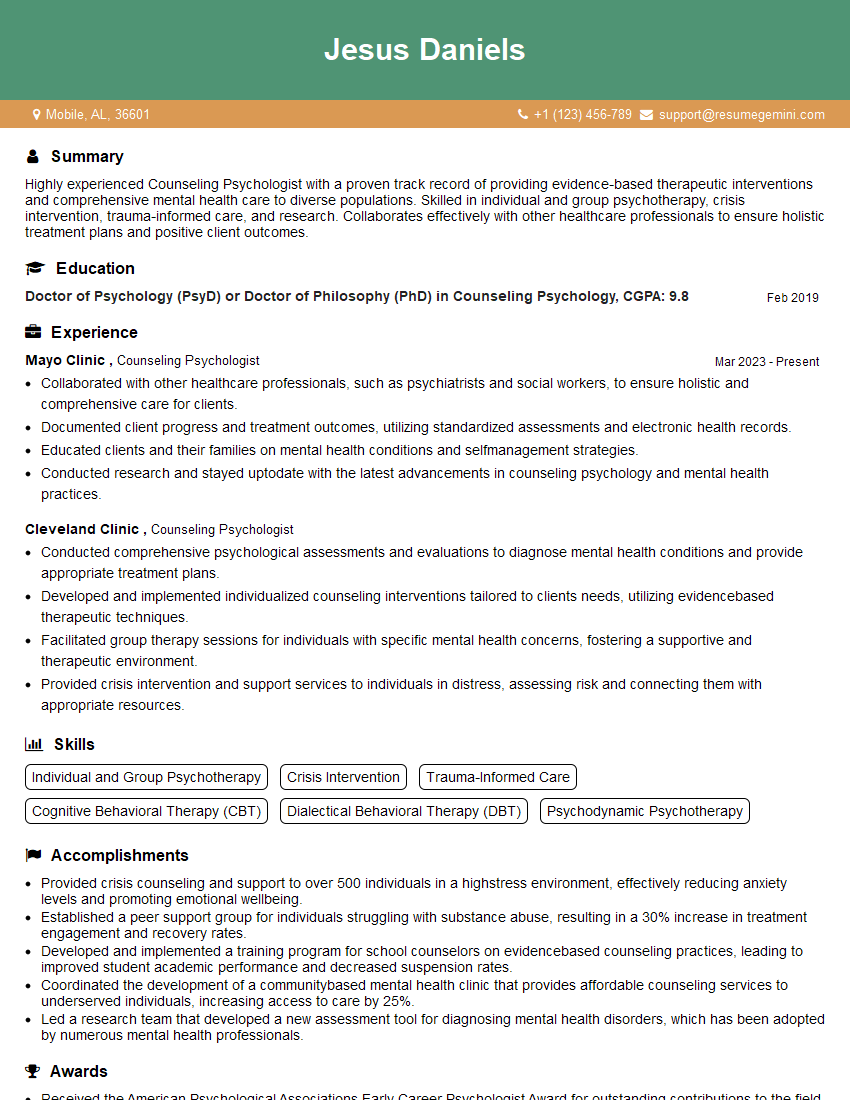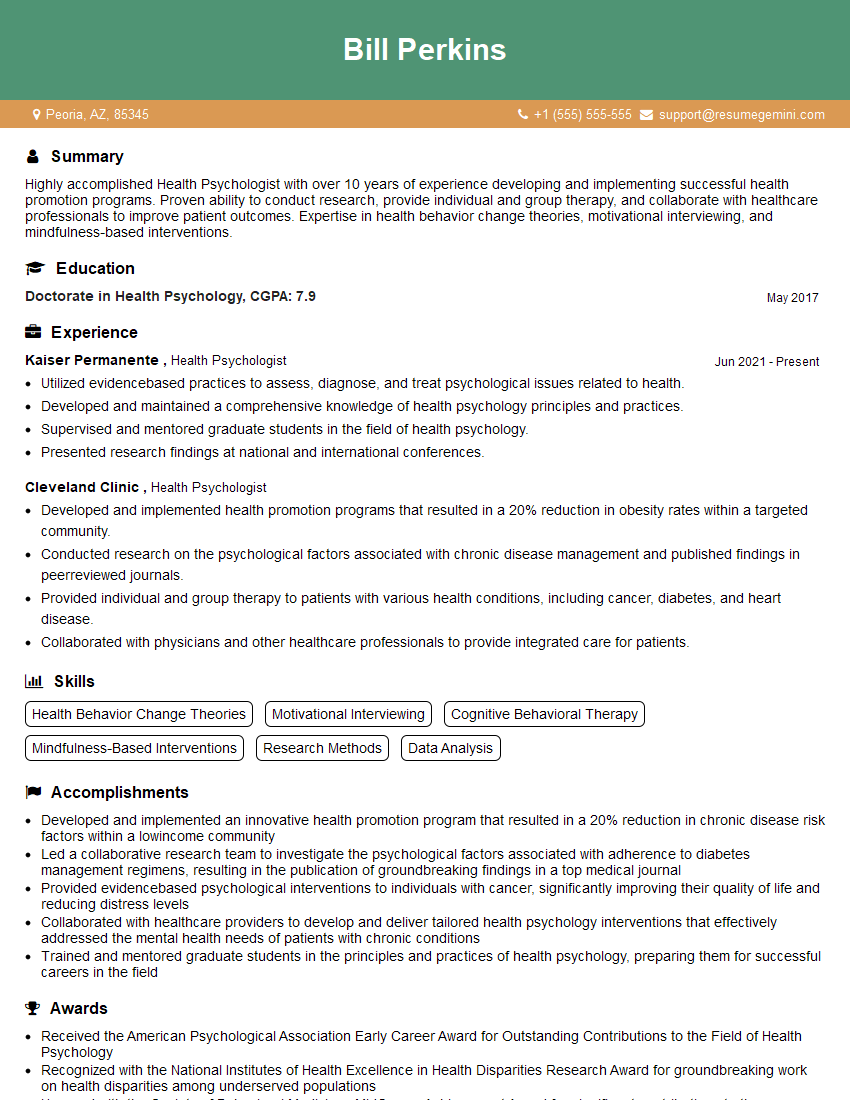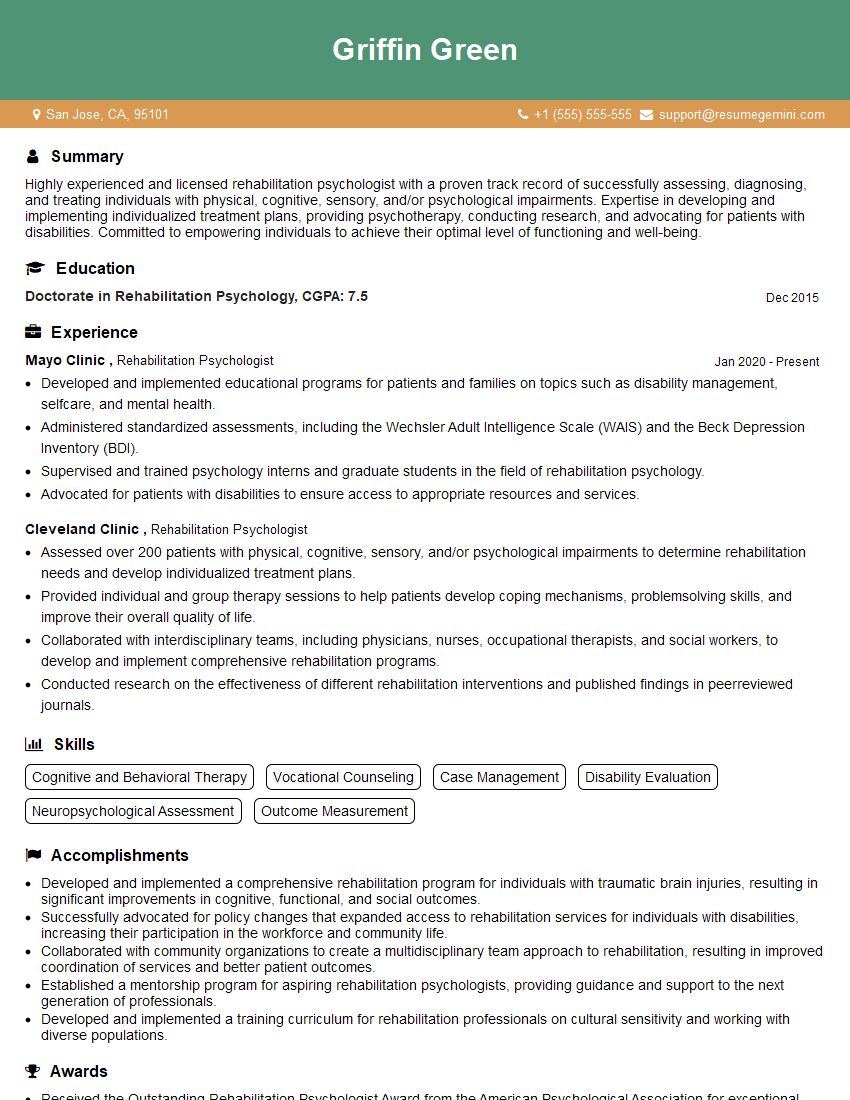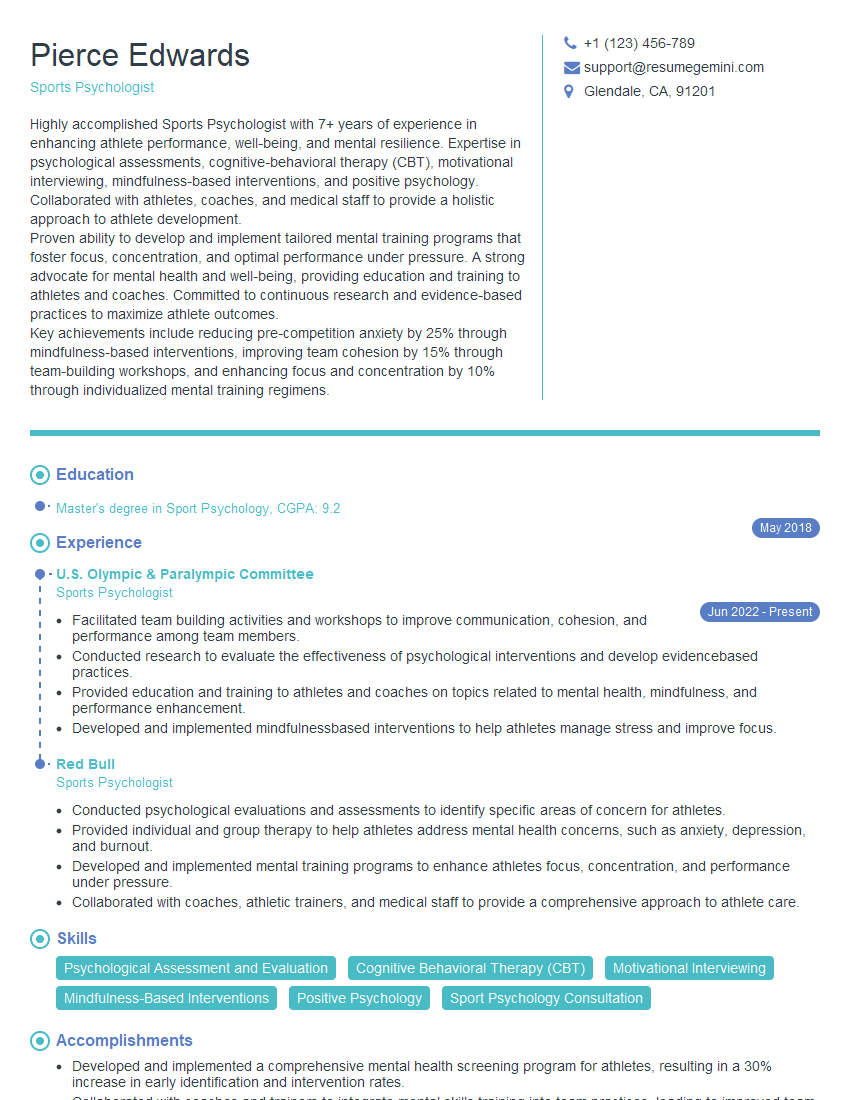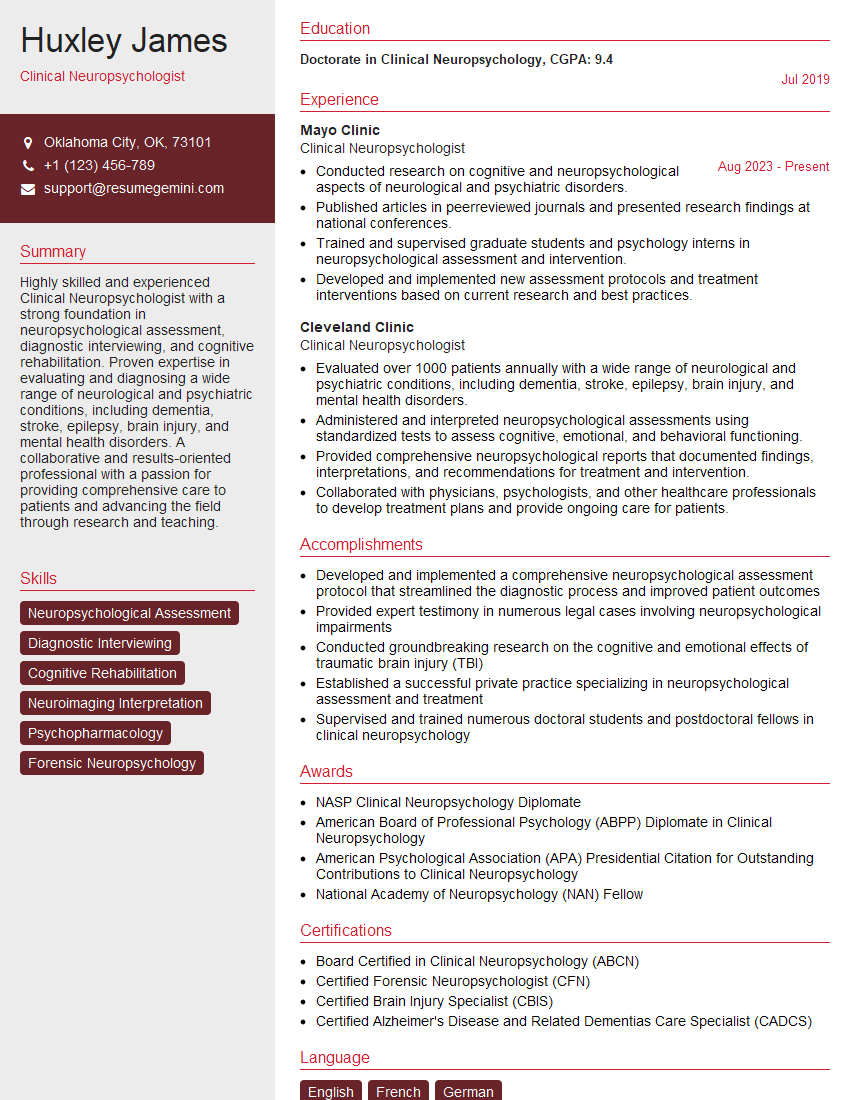Every successful interview starts with knowing what to expect. In this blog, we’ll take you through the top Psychological Evaluation interview questions, breaking them down with expert tips to help you deliver impactful answers. Step into your next interview fully prepared and ready to succeed.
Questions Asked in Psychological Evaluation Interview
Q 1. Describe your experience administering the Wechsler Adult Intelligence Scale (WAIS).
I have extensive experience administering the Wechsler Adult Intelligence Scale (WAIS), having administered it to hundreds of clients across diverse backgrounds and presenting problems. My proficiency encompasses all subtests within the WAIS-IV and WAIS-V, including the Verbal Comprehension, Perceptual Reasoning, Working Memory, and Processing Speed indices. I am meticulous in following standardized administration procedures, ensuring a comfortable and supportive testing environment to minimize test anxiety and maximize client performance. This involves careful explanation of instructions, monitoring for fatigue, and addressing any client questions or concerns. For example, with a client exhibiting anxiety, I might incorporate brief breaks or adjust the testing schedule to accommodate their needs. Post-administration, I meticulously score the tests using the official scoring manuals and then interpret the results within the context of the client’s background, referral question, and other relevant assessment data.
A recent case involved a young professional referred for cognitive testing following a head injury. Accurate administration of the WAIS allowed us to identify specific cognitive deficits, informing targeted rehabilitation strategies. This highlights the importance of precise administration and interpretation, as subtle variations can significantly impact results and subsequent treatment planning.
Q 2. Explain the differences between objective and projective psychological tests.
Objective and projective tests represent two distinct approaches to psychological assessment. Objective tests, such as the Minnesota Multiphasic Personality Inventory (MMPI-2-RF) or the NEO PI-R, employ standardized questions with limited response options, usually multiple choice or true/false. Scoring is objective and relies on pre-established norms. Think of them like a multiple-choice exam – the scoring is straightforward. The strength lies in their quantifiable results and ease of administration and scoring. However, they can be susceptible to response bias (e.g., social desirability).
In contrast, projective tests like the Rorschach Inkblot Test or the Thematic Apperception Test (TAT) present ambiguous stimuli (inkblots or pictures) that clients respond to freely. The responses are then interpreted by the examiner, focusing on underlying themes, emotional expression, and cognitive processes. It’s like providing a blank canvas and observing how the individual paints their own interpretation. These tests aim to uncover unconscious thoughts and feelings, offering valuable insights into personality dynamics. However, the subjectivity of interpretation introduces the potential for lower reliability and validity compared to objective tests.
The choice between objective and projective tests depends on the assessment goals. For instance, objective tests are often used for screening for specific disorders, while projective tests can be helpful in exploring complex personality dynamics in therapy.
Q 3. How do you ensure the validity and reliability of your assessment findings?
Ensuring the validity and reliability of assessment findings is paramount. Validity refers to whether the test measures what it intends to measure, while reliability indicates the consistency of the test’s results over time and across different raters. I employ several strategies to achieve this.
- Using standardized tests: Established tests like the WAIS and MMPI have undergone rigorous testing for validity and reliability.
- Adhering to standardized administration procedures: Consistent administration minimizes extraneous factors influencing results.
- Careful scoring: I use official scoring manuals to ensure accuracy and minimize scoring errors.
- Triangulation of data: I integrate information from multiple sources, including interviews, collateral information, and other assessment data, to corroborate findings. This helps reduce reliance on any single measure.
- Considering the context: Interpreting results within the context of the individual’s life circumstances and presenting problem is critical for accurate conclusions.
For example, if a client scores low on a particular subtest of the WAIS, I wouldn’t solely rely on that score. I would consider factors like their education, cultural background, and potential language barriers before drawing conclusions.
Q 4. Discuss your approach to interpreting psychological test results.
Interpreting psychological test results is a complex process that goes beyond simply looking at raw scores. My approach involves a holistic and integrative perspective. It begins with a thorough review of the referral question and relevant background information. Then I analyze the test data, considering the individual’s performance on each subtest or scale. I carefully examine patterns of strengths and weaknesses, looking for discrepancies or inconsistencies that might warrant further investigation.
I don’t interpret scores in isolation; instead, I integrate them with information gathered from clinical interviews, collateral information (e.g., from family members or teachers), and observations during the assessment. This process allows for a comprehensive understanding of the individual’s functioning. For example, a low score on a memory test might be explained by a reported history of head trauma, thereby contextualizing the score.
Finally, I formulate an integrated interpretation, summarizing the findings in a clear and concise manner, addressing the referral question, and offering recommendations for treatment or further assessment. I also consider the potential limitations of the assessment, ensuring transparency and avoiding overgeneralizations.
Q 5. What ethical considerations are crucial when conducting psychological evaluations?
Ethical considerations are paramount in psychological evaluations. These include:
- Confidentiality: Maintaining client confidentiality is crucial, abiding by all relevant legal and ethical guidelines.
- Informed consent: Clients must be fully informed about the purpose, procedures, and limitations of the assessment before consenting to participate.
- Competence: I only undertake evaluations within my area of expertise, referring clients to other professionals when necessary.
- Cultural sensitivity: Assessments must be culturally appropriate and consider the impact of cultural factors on test performance.
- Avoiding bias: I strive for objectivity, minimizing personal biases in my interpretations.
- Test security: Maintaining the integrity of the test materials is essential, preventing unauthorized access or disclosure.
- Responsibility to clients: Ensuring that the evaluation results are communicated clearly and ethically to the client and relevant parties is crucial.
For example, if a client reveals information about potential harm to themselves or others, I have an ethical obligation to take appropriate action, which may include contacting relevant authorities.
Q 6. Describe your experience with different personality assessment inventories (e.g., MMPI, NEO PI-R).
My experience encompasses a wide range of personality assessment inventories. I am proficient in administering, scoring, and interpreting the MMPI-2-RF, a widely used objective personality test that assesses various psychological constructs, including clinical scales, validity scales, and content scales. I also have significant experience with the NEO PI-R, a measure of the Five-Factor Model (FFM) of personality, offering insights into neuroticism, extraversion, openness, agreeableness, and conscientiousness.
The MMPI-2-RF is particularly useful in identifying potential psychopathology, while the NEO PI-R provides a more comprehensive profile of personality traits. My approach always involves integrating the findings from these tests with other assessment data to obtain a richer understanding of the individual. For example, I might use the MMPI-2-RF to screen for potential personality disorders and then use the NEO PI-R to explore the specific traits contributing to those disorders.
Q 7. How do you handle situations where test results contradict clinical observations?
Discrepancies between test results and clinical observations are not uncommon and require careful consideration. My approach involves systematically investigating the reasons for the discrepancy. First, I re-examine the test administration and scoring procedures to rule out any technical errors. Then, I review the clinical observations, seeking clarification and considering any factors that might have influenced my perceptions.
Next, I consider potential contextual factors that might explain the discrepancy. For instance, a client might present differently in a formal testing setting than during a less structured interview. Cultural differences, language barriers, and response biases can also affect the results. Finally, I integrate all the available data, considering the strengths and limitations of each method. The goal is to arrive at a comprehensive understanding that accounts for both the test results and clinical observations, often leading to a more nuanced and complete assessment. This process might involve further assessment, a change in treatment plan, or consultation with a colleague.
Q 8. Explain your understanding of differential diagnosis in psychological assessment.
Differential diagnosis in psychological assessment is the process of systematically differentiating between various possible diagnoses that share similar symptoms. It’s like being a detective, carefully examining clues to arrive at the most accurate conclusion. Instead of focusing on a single potential disorder, we consider multiple possibilities and weigh their likelihood based on the client’s presentation.
For instance, a client presenting with anxiety symptoms might also be experiencing depression, a personality disorder, or even a medical condition mimicking anxiety. A thorough differential diagnosis involves reviewing the client’s history, conducting various assessments (e.g., interviews, questionnaires, observations), and considering the diagnostic criteria for each potential disorder outlined in the DSM-5 or ICD-11. This process helps to avoid misdiagnosis and ensures that the client receives the most appropriate and effective treatment.
A crucial part of differential diagnosis is considering the interplay of different factors. For example, a client might experience both anxiety and substance abuse; understanding their relationship is essential for effective treatment planning. This requires careful consideration of symptom onset, duration, severity, and the client’s overall functioning.
Q 9. How do you tailor your assessment approach to different age groups and populations?
Tailoring my assessment approach to different age groups and populations is crucial for accurate and meaningful results. Children, adolescents, and adults have vastly different developmental stages, cognitive abilities, and social contexts which influence their responses to assessments.
- Children: I use age-appropriate methods like play therapy, drawings, and parent interviews, in addition to standardized tests adapted for younger ages. The language used must be simple and engaging, understanding that a child’s understanding of their emotions might be less sophisticated than an adult’s.
- Adolescents: This group requires a sensitive approach acknowledging the developmental challenges unique to adolescence (identity formation, peer relationships, etc.). I incorporate methods that address confidentiality, allowing them to share openly while maintaining ethical standards. I also consider the impact of peer pressure and social media on their mental health.
- Adults: Assessments for adults typically involve more complex questionnaires and in-depth interviews, exploring their life history, relationships, and work situations. The focus might be on specific areas such as occupational functioning or relational difficulties.
- Specific Populations: Individuals with intellectual disabilities, neurological impairments, or cultural backgrounds different from my own require specific adjustments. This could involve utilizing alternative assessment methods, adapting instructions, or engaging interpreters.
In each case, maintaining a strong therapeutic alliance and ensuring the client feels comfortable and understood is paramount for the success of the assessment.
Q 10. Discuss your familiarity with neuropsychological assessment techniques.
Neuropsychological assessment involves evaluating cognitive functions like memory, attention, language, executive functions, and visuospatial skills. These assessments are crucial in identifying the nature and extent of brain injury or neurological disorders such as Alzheimer’s disease, traumatic brain injury (TBI), or stroke.
My familiarity encompasses various techniques including:
- Standardized Tests: I’m proficient in administering and interpreting standardized neuropsychological tests such as the Wechsler Memory Scale (WMS), the Trail Making Test, and the Wisconsin Card Sorting Test (WCST).
- Behavioral Observations: I carefully observe the client’s behavior during the testing process, noting any inconsistencies or difficulties that may not be captured by test scores.
- Interviewing: Gathering information from the client, family members, or other relevant sources is essential to understand the context of the cognitive difficulties.
- Review of Medical Records: A thorough review of medical records, including neurological imaging (e.g., MRI, CT scans), is crucial for a comprehensive neuropsychological evaluation.
Interpreting the results involves considering the client’s age, education, cultural background, and premorbid (pre-illness) functioning. The goal is not just to identify deficits but also to understand their impact on daily life and suggest appropriate interventions and support.
Q 11. Describe your experience with cognitive-behavioral assessments.
Cognitive-behavioral (CBT) assessments focus on identifying and modifying maladaptive thoughts, feelings, and behaviors. These assessments are highly structured and usually involve a combination of techniques aimed at understanding the client’s specific cognitive distortions and behavioral patterns.
My experience includes utilizing various CBT assessment tools such as:
- Structured Interviews: These are standardized interviews designed to assess specific cognitive and behavioral patterns related to various disorders (e.g., anxiety, depression).
- Self-Report Measures: Questionnaires and inventories, such as the Beck Depression Inventory (BDI) or the State-Trait Anxiety Inventory (STAI), are used to quantify the client’s experiences.
- Behavioral Observation: Observing the client’s behavior in different contexts helps to identify triggers and maintain patterns.
- Thought Records: Working with clients to monitor their thoughts, feelings, and behaviors in specific situations allows for the identification of cognitive distortions and behavioral patterns requiring modification.
The information gathered through these assessments informs the development of a personalized CBT treatment plan targeted at modifying maladaptive thoughts and behaviors.
Q 12. How do you ensure cultural sensitivity in your assessment practices?
Cultural sensitivity is paramount in psychological assessment. Ignoring cultural factors can lead to inaccurate diagnoses and ineffective treatments. I ensure cultural sensitivity by:
- Understanding Cultural Norms: I strive to understand the cultural values, beliefs, and communication styles of the client. This includes recognizing that what might be considered normal behavior in one culture might be viewed as problematic in another.
- Using Culturally Appropriate Assessment Tools: I select and use assessment tools that have been validated for use with the client’s specific cultural group. If validated tools are not available, I carefully consider the potential biases and limitations of the instruments used.
- Considering Language Barriers: I ensure that the assessment process is conducted in the client’s preferred language, or I engage qualified interpreters when necessary.
- Building Rapport: Building trust and rapport is essential, especially with clients from different cultural backgrounds. This often means adjusting my communication style and showing respect for their beliefs and values.
- Collaborating with Community Resources: When appropriate, I collaborate with community organizations and cultural specialists to enhance my understanding of the client’s cultural context and available support resources.
Cultural competence is an ongoing process of learning and self-reflection. I regularly engage in professional development activities that focus on cultural sensitivity and diversity in psychological assessment.
Q 13. What strategies do you employ to build rapport with clients during assessments?
Building rapport is fundamental to a successful psychological assessment. It creates a safe and trusting environment where clients feel comfortable sharing sensitive information. I employ several strategies:
- Active Listening: I pay close attention to the client’s verbal and nonverbal cues, showing genuine interest and empathy.
- Empathetic Communication: I try to understand the client’s perspective and experiences, conveying my understanding through verbal and nonverbal communication.
- Clear and Concise Communication: I use language that the client can easily understand, avoiding technical jargon.
- Respectful and Non-Judgmental Attitude: I create a safe space for the client to share their thoughts and feelings without fear of judgment.
- Establishing Confidentiality: I clearly explain the limits of confidentiality from the outset.
- Setting Realistic Expectations: I clearly explain the assessment process, what will be involved, and the potential outcomes.
For example, I might begin an assessment by asking about their hobbies or interests to establish a common ground and create a more relaxed atmosphere. This humanizes the interaction, making it more of a collaboration than an interrogation.
Q 14. Explain your understanding of the limitations of psychological testing.
Psychological testing, while valuable, has limitations. It’s crucial to understand these to interpret results accurately and avoid misinterpretations.
- Test Bias: Tests can be biased against certain groups due to cultural factors, language barriers, or other factors. This can lead to inaccurate or unfair assessments.
- Limited Scope: Tests measure specific aspects of personality or functioning; they don’t provide a complete picture of an individual’s life or experiences.
- Subjectivity in Interpretation: There’s some subjectivity in interpreting test results, even with standardized tests. Different clinicians might interpret the same data differently.
- Test Anxiety: A client’s anxiety during testing can affect their performance, potentially leading to inaccurate results.
- Response Bias: Clients may respond in ways that they believe are socially desirable or that they think the clinician wants to hear.
- Lack of Ecological Validity: Test results might not always predict real-world behavior or functioning accurately. For example, a great performance on a memory test might not translate into excellent memory in everyday life.
Therefore, I always integrate test results with other information gathered from clinical interviews, observations, and collateral sources to obtain a more holistic understanding. I emphasize that the test is only one piece of the puzzle, and the client’s unique experiences and context are crucial for accurate interpretation.
Q 15. How do you communicate assessment results to clients and other professionals?
Communicating assessment results is a crucial aspect of ethical and effective psychological practice. It involves tailoring the information to the recipient’s understanding and needs, while maintaining the client’s confidentiality. When communicating with clients, I prioritize a collaborative approach. I begin by summarizing the key findings in clear, non-technical language, avoiding jargon. I then explore their understanding of the results and answer their questions patiently and thoroughly. I might use visual aids like graphs or charts to illustrate complex data where appropriate. For professionals, such as referring physicians or attorneys, my report writing (detailed below) provides the comprehensive information they require, adhering to professional standards and relevant legal requirements.
For example, I might explain to a client that their scores indicate a moderate level of anxiety, rather than simply stating a numerical score on a standardized test. I would then discuss the implications of this finding for their daily life and potential treatment options. In contrast, a report to a physician would provide detailed test scores, interpretations based on established norms, and a diagnostic impression according to DSM-5 criteria.
Career Expert Tips:
- Ace those interviews! Prepare effectively by reviewing the Top 50 Most Common Interview Questions on ResumeGemini.
- Navigate your job search with confidence! Explore a wide range of Career Tips on ResumeGemini. Learn about common challenges and recommendations to overcome them.
- Craft the perfect resume! Master the Art of Resume Writing with ResumeGemini’s guide. Showcase your unique qualifications and achievements effectively.
- Don’t miss out on holiday savings! Build your dream resume with ResumeGemini’s ATS optimized templates.
Q 16. Describe your experience with report writing for psychological evaluations.
Report writing is a cornerstone of my practice. My reports are structured logically, following a consistent format designed for clarity and accessibility. They typically include a comprehensive overview of the referral question, a detailed description of the assessment methods used (including specific tests), the results obtained, an interpretation of those results, and a summary of my clinical impressions and recommendations. I strive to write in a concise yet thorough manner, using precise language and avoiding ambiguity. The style is tailored to the intended audience. Reports for clinicians emphasize clinical data and diagnostic reasoning; reports for legal contexts address the specific questions posed by the referring attorney. I meticulously review each report before submission to ensure accuracy, clarity, and adherence to ethical guidelines.
For example, a report for a child custody evaluation would differ significantly from a report for a personal injury case. The former might focus on the child’s well-being and parental capabilities, while the latter would focus on the client’s psychological functioning and its impact on their ability to work or engage in daily activities. In both cases, though, the report will cite the evidence supporting my conclusions and avoid speculation.
Q 17. How do you maintain confidentiality and comply with HIPAA regulations?
Maintaining client confidentiality and complying with HIPAA regulations are paramount. I follow strict procedures to safeguard Protected Health Information (PHI). This includes secure storage of physical and electronic records, using password-protected computers and encrypted email, and limiting access to PHI to authorized personnel only. I obtain informed consent before releasing any information to third parties, ensuring that clients understand the limits of confidentiality and the potential exceptions (e.g., mandated reporting of child abuse). All electronic systems utilized are HIPAA compliant and regularly updated with the latest security patches. I also maintain thorough documentation of all consent forms and communications.
Imagine a scenario where a client reveals suicidal ideation. While respecting confidentiality, I have an ethical obligation to take appropriate action to ensure their safety, potentially involving emergency intervention or consultation with other professionals. In such instances, I would document the steps taken in accordance with HIPAA and ethical guidelines, while being mindful of the client’s right to privacy.
Q 18. What is your approach to dealing with challenging or resistant clients?
Working with challenging or resistant clients requires patience, empathy, and a flexible approach. I start by establishing rapport and building trust. I listen actively, acknowledging their concerns and validating their feelings. I clearly explain the assessment process and its purpose, providing opportunities for them to express their reservations. If resistance persists, I explore the reasons behind it, trying to understand their perspective and address any misunderstandings or anxieties. Collaboration is key; I will adjust my assessment methods if needed, always prioritizing the client’s comfort and cooperation while still adhering to professional standards.
For instance, if a client is uncomfortable with certain types of assessments, I might explore alternative methods that achieve the same objective. Perhaps a semi-structured interview would be more suitable than a structured test. Open communication and flexibility are crucial in these situations. If necessary, I might involve other members of the treatment team or refer the client to a more appropriate professional.
Q 19. Explain your experience using technology in psychological assessment (e.g., computerized testing).
I have extensive experience using technology in psychological assessment. I am proficient in administering and interpreting results from various computerized testing platforms. These platforms offer advantages such as efficient scoring, enhanced data management, and access to normative data. They also provide features such as adaptive testing, which adjusts the difficulty of questions based on the individual’s responses, optimizing accuracy and minimizing testing time. I carefully consider the validity and reliability of computerized assessments, ensuring they are appropriate for the client and the referral question. For example, I routinely use computerized versions of the MMPI-2-RF and various neuropsychological assessments.
One specific example is the use of computerized cognitive testing. These tests often incorporate features like reaction-time measurements, providing a more nuanced understanding of cognitive functioning compared to traditional paper-and-pencil assessments. However, it’s important to address the client’s comfort and technical literacy. In some cases, it may be more effective to use traditional methods.
Q 20. How do you stay current with the latest developments in psychological assessment?
Staying current with the latest developments in psychological assessment is essential for maintaining competence and providing the best possible care to clients. I regularly attend professional conferences and workshops, read peer-reviewed journals, and participate in continuing education courses. I am a member of professional organizations such as the American Psychological Association (APA), which provides access to cutting-edge research and best practices. I also actively follow relevant publications and online resources, ensuring I remain informed about advancements in testing methodologies, diagnostic criteria, and ethical standards.
For instance, I actively follow the updates and revisions to the DSM, constantly educating myself on emerging research and the implications of these changes for clinical practice. I also utilize online resources and databases like PsycINFO to search for research relevant to specific assessment questions or challenges that I encounter.
Q 21. Describe a time you had to revise your initial assessment plan.
There was a case where I initially planned to use a specific intelligence test for a child referred for learning difficulties. However, during the initial interview, it became apparent that the child was experiencing significant anxiety and difficulty concentrating, likely due to recent family trauma. Administering a lengthy, demanding intelligence test under those circumstances would have yielded unreliable and invalid results. Therefore, I revised my assessment plan. Instead of solely focusing on an IQ test, I incorporated other measures, including a comprehensive clinical interview, observations of the child’s behavior, and less demanding assessments of cognitive functioning. This allowed me to gather a more accurate and holistic understanding of the child’s cognitive abilities and emotional state, informing more effective intervention strategies.
This experience highlighted the importance of flexibility and adaptability in assessment planning. It’s crucial to remain attuned to the client’s needs and circumstances, adjusting the assessment accordingly to ensure the process is both accurate and effective. The focus is always on obtaining a comprehensive and valid picture of the client’s functioning, not rigidly adhering to a pre-determined plan.
Q 22. Explain your understanding of different scoring methods for psychological tests.
Psychological test scoring methods vary widely depending on the specific instrument. Some tests use norm-referenced scoring, comparing an individual’s performance to a larger group’s performance (the norm group). This often results in scores like percentiles or standard scores (e.g., T-scores, z-scores). For example, a T-score of 70 on an anxiety scale might indicate above-average anxiety levels, as this is one standard deviation above the mean of 50.
Other tests use criterion-referenced scoring, evaluating performance against a specific standard or criterion rather than a comparison group. A driving test, for instance, is criterion-referenced; the individual must meet a set of criteria to pass, regardless of how others performed. In psychological assessment, this might involve assessing whether a client meets diagnostic criteria for a particular disorder.
Ipsative scoring compares an individual’s performance across different scales within the same test. This allows for an intra-individual comparison, revealing relative strengths and weaknesses. For instance, an ipsative personality test might reveal that while a client scores high overall, their score on the sociability scale is relatively lower than their score on conscientiousness.
Finally, some tests use a combination of these methods. Understanding the scoring method is crucial for accurate interpretation of the results, as misinterpreting the meaning of a score can lead to inaccurate diagnoses and treatment plans.
Q 23. How do you handle situations where there are conflicting interpretations of test results?
Conflicting interpretations of test results are a common challenge in psychological evaluation. My approach involves a systematic process:
- Reviewing the data thoroughly: I carefully examine the raw data, scores, and profiles from all tests administered, looking for patterns and inconsistencies.
- Considering the context: I examine the client’s background, history, presenting problem, and the circumstances surrounding the testing. A low score on a particular test might be explained by factors like fatigue, anxiety, or cultural differences.
- Consulting relevant literature: I review research on the specific tests used and look for studies addressing potential conflicting results or factors impacting test validity.
- Seeking consultation if needed: If I’m still unsure, I consult with other professionals with expertise in the relevant area to gain a broader perspective and ensure a comprehensive understanding.
- Prioritizing clinical judgment: Ultimately, I rely on my clinical judgment, integrating all available information to reach the most plausible interpretation. Test results are valuable but only one piece of the puzzle.
For example, if a personality test suggests introversion but the clinical interview reveals a very outgoing and socially active individual, I would investigate potential reasons for this discrepancy – was the test validly administered? Did the client misunderstand the questions? Understanding the context is crucial for resolving such conflicts.
Q 24. Discuss your familiarity with evidence-based assessment practices.
Evidence-based assessment is central to my practice. This means integrating the best available research evidence with clinical expertise and client values to inform the assessment process. This involves using:
- Psychometrically sound instruments: I select tests with demonstrated reliability and validity, ensuring they are appropriate for the client’s age, culture, and presenting problem. I refer to resources like the Mental Measurements Yearbook for guidance.
- Structured clinical interviews: Structured interviews help ensure consistency and reduce bias in data collection, and they improve diagnostic accuracy compared to unstructured interviews.
- Empirical findings: I consult research literature to understand the strengths and limitations of each assessment tool and to interpret results accurately.
- Best practices: I stay updated on the latest research and guidelines in psychological assessment to maintain the highest standards of practice.
For instance, choosing the Wechsler Adult Intelligence Scale (WAIS) instead of a less-validated intelligence test is an example of evidence-based practice. The WAIS has robust psychometric properties, supporting its use in clinical settings.
Q 25. How do you integrate information from multiple sources (e.g., interviews, observations, test data)?
Integrating information from multiple sources is critical for a comprehensive and accurate psychological evaluation. I use a process of convergent validation, where I look for consistency across different sources of data. If the information from different sources supports the same conclusions, it strengthens the overall assessment.
For example, if a client reports high levels of anxiety during an interview, shows signs of anxiety during observation, and scores high on an anxiety measure, this convergence strengthens the conclusion that anxiety is a significant concern. Discrepancies, however, demand a thorough investigation. I might then look at potential biases, explore possible explanations for inconsistencies, and carefully consider the relative weight given to each type of data in the final report.
I use a systematic approach, documenting all information clearly and carefully considering the potential biases associated with each data source. This ensures a holistic understanding of the individual and avoids relying solely on a single piece of information.
Q 26. Describe your experience working with diverse populations.
I have extensive experience working with diverse populations, including individuals from various cultural backgrounds, socioeconomic statuses, and age groups. I recognize that cultural factors can significantly impact assessment and interpretation. Therefore, I take steps to ensure cultural sensitivity and competence:
- Using culturally appropriate assessment tools: I choose tests that are standardized and validated for the client’s cultural group or that are designed to minimize cultural bias.
- Being mindful of language barriers: I ensure that assessments are conducted in the client’s preferred language, either directly or through qualified interpreters.
- Considering cultural nuances: I understand that different cultures have varying interpretations of symptoms and behaviors. I strive to contextualize test results within the client’s cultural framework.
- Building rapport and trust: I focus on establishing a strong therapeutic relationship to make clients feel comfortable and safe sharing information.
For example, I would avoid relying solely on Western-normed tests when assessing individuals from different cultural backgrounds. Instead, I may use culturally adapted measures or utilize qualitative methods to supplement quantitative data.
Q 27. How do you manage time effectively during psychological evaluations?
Effective time management during psychological evaluations is crucial. My strategies include:
- Careful planning and scheduling: I allocate sufficient time for each assessment phase based on its complexity. This includes scheduling breaks if needed.
- Utilizing technology: I use electronic record-keeping systems to streamline the documentation process and minimize administrative time.
- Prioritizing tasks: I prioritize the most essential aspects of the evaluation to ensure that all critical information is obtained within the allocated time.
- Efficient report writing: I use templates and standardized formats to improve efficiency in report writing. I also break down the report writing process into smaller, manageable tasks.
- Setting realistic goals: I avoid over-scheduling and ensure enough time for unexpected events or delays that can occur during an assessment.
Time management is about being efficient without sacrificing the quality of the assessment. Rushing can lead to errors and compromise the accuracy of the results.
Q 28. What are your strengths and weaknesses as a psychological evaluator?
Strengths: I possess strong clinical judgment, excellent interpersonal skills, and a commitment to evidence-based practices. I’m adept at building rapport with clients from diverse backgrounds, ensuring they feel comfortable and safe during the assessment. My ability to integrate information from multiple sources allows for comprehensive evaluations. I consistently strive for accuracy and thoroughness in my work.
Weaknesses: Like any professional, I continually work on refining my skills. One area I focus on is further developing my expertise in working with specific populations, such as individuals with severe personality disorders. I am also striving to improve my speed and efficiency in report writing without compromising thoroughness and clarity. This is an ongoing process of professional development and self-reflection.
Key Topics to Learn for Psychological Evaluation Interview
- Assessment Techniques: Understanding and applying various psychological assessment methods (e.g., projective tests, objective inventories, neuropsychological assessments). Consider the strengths and limitations of each approach.
- Diagnostic Frameworks: Deep familiarity with the DSM-5 and/or ICD-11 criteria for diagnosing mental health disorders. Practice applying these criteria to hypothetical case studies.
- Ethical Considerations: Mastering ethical principles and guidelines related to confidentiality, informed consent, and cultural sensitivity in psychological assessment.
- Report Writing: Developing clear, concise, and comprehensive psychological reports that effectively communicate assessment findings and recommendations to relevant parties.
- Data Interpretation: Developing strong analytical skills to interpret complex psychological data, including statistical analysis and qualitative data interpretation.
- Cultural Competence: Understanding and addressing the impact of cultural factors on assessment and diagnosis. Consider the challenges and best practices for working with diverse populations.
- Test Validity and Reliability: Critically evaluating the psychometric properties of assessment instruments, including understanding concepts of validity and reliability and their implications for assessment decisions.
- Clinical Judgment and Decision-Making: Developing strong clinical reasoning skills to integrate assessment data with clinical observations and make informed decisions about diagnosis and treatment.
Next Steps
Mastering psychological evaluation is crucial for career advancement in the field, opening doors to exciting opportunities in research, clinical practice, and forensic psychology. To maximize your job prospects, building a strong, ATS-friendly resume is essential. ResumeGemini can help you create a compelling resume that showcases your skills and experience effectively. We provide examples of resumes tailored to Psychological Evaluation to guide you through the process. Take the next step towards your dream career today!
Explore more articles
Users Rating of Our Blogs
Share Your Experience
We value your feedback! Please rate our content and share your thoughts (optional).
What Readers Say About Our Blog
Hi, I have something for you and recorded a quick Loom video to show the kind of value I can bring to you.
Even if we don’t work together, I’m confident you’ll take away something valuable and learn a few new ideas.
Here’s the link: https://bit.ly/loom-video-daniel
Would love your thoughts after watching!
– Daniel
This was kind of a unique content I found around the specialized skills. Very helpful questions and good detailed answers.
Very Helpful blog, thank you Interviewgemini team.
